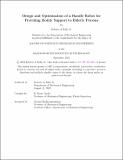| dc.contributor.advisor | Asada, H. Harry | |
| dc.contributor.author | Bolli Jr., Roberto A. | |
| dc.date.accessioned | 2023-11-02T20:23:38Z | |
| dc.date.available | 2023-11-02T20:23:38Z | |
| dc.date.issued | 2023-09 | |
| dc.date.submitted | 2023-09-28T15:49:51.770Z | |
| dc.identifier.uri | https://hdl.handle.net/1721.1/152870 | |
| dc.description.abstract | Age-related loss of mobility and an increased risk of falling remain major obstacles for
older adults to live independently. Many elderly people lack the coordination and strength
necessary to perform activities of daily living, such as getting out of bed or stepping into
a bathtub. A traditional solution is to install grab bars around the home. For assisting in
bathtub transitions, grab bars are fixed to a bathroom wall. However, they are often too far
to reach and stably support the user; the installation locations of grab bars are constrained
by the room layout and are often suboptimal. In this thesis, we present a mobile robot that
provides an older adult with a handlebar located anywhere in space - “Handle Anywhere”.
The robot consists of an omnidirectional mobile base attached to a repositionable handlebar.
We further develop a methodology to optimally place the handle to provide the maximum
support for the elderly user while performing common postural changes. A cost function
with a trade-off between mechanical advantage and manipulability of the user’s arm was
optimized in terms of the location of the handlebar relative to the user. The methodology
requires only a sagittal plane video of the elderly user performing the postural change, and
thus is rapid, scalable, and uniquely customizable to each user. A proof-of-concept prototype
was built, and the optimization algorithm for handle location was validated experimentally.
Additionally, we present the results of a study to discover any correlations between an
elderly person’s preferred handlebar pose and various demographic indicators, self-rated
mobility for tasks requiring postural change, and biomechanical markers. For simplicity,
we considered only the case where the handlebar was positioned directly in front of the
user, as this confined the relevant body kinematics to a 2D sagittal plane. This data-driven
approach complements the cost function described earlier by assessing how a handlebar
should be positioned based on data from actual elderly people.
Lastly, we introduce a novel design for a wheel capable of changing configuration based
on the surface underneath it, such that there will always be a high coefficient of friction
between the wheel and the ground. The wheel design was refined through experimental tests
on various floor surfaces commonly found in the homes of elderly people. | |
| dc.publisher | Massachusetts Institute of Technology | |
| dc.rights | Attribution-NonCommercial-NoDerivatives 4.0 International (CC BY-NC-ND 4.0) | |
| dc.rights | Copyright retained by author(s) | |
| dc.rights.uri | https://creativecommons.org/licenses/by-nc-nd/4.0/ | |
| dc.title | Design and Optimization of a Handle Robot for Providing Bodily Support to Elderly Persons | |
| dc.type | Thesis | |
| dc.description.degree | S.M. | |
| dc.contributor.department | Massachusetts Institute of Technology. Department of Mechanical Engineering | |
| mit.thesis.degree | Master | |
| thesis.degree.name | Master of Science in Mechanical Engineering | |
